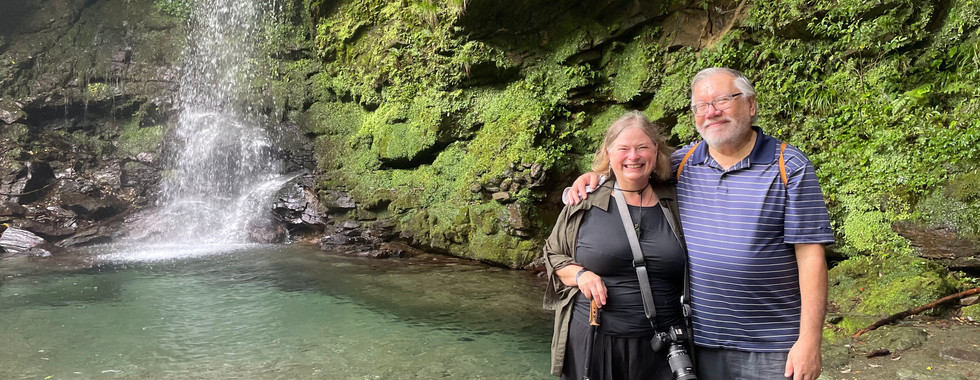(Not all photos are in the Japanese version.)

Paul and I have been married for almost 40 years, and he is very knowledgeable about Japan and Japanese customs. He was born on a U.S. Army base in Osaka in 1957 to an American dad and a Japanese mother. They moved to the U.S. when he was a baby. I've heard a lot about the country & the culture over the years. Yet, after a month into our stay here, I'm slowly coming to realize that I've had a lot of misconceptions about the foundations of the cultural mores here. I, and other Westerners, I think, typically think of the Japanese as having a lot of "rules" - you have to take your shoes off before entering a home, or you can't speak on the subway. But "rules" as we think of them are not really the foundation of this society. Instead, Japanese people have deeply internalized beliefs about how they can live peacefully and joyfully in a densely populated small space.
I have been very nervous about unintentionally breaking the "rules". Unlike most of the places we've been visiting this year, Japan is not a multi-cultural society. It is remarkably homogenous. And that is different.
Paul began raising the topic of attire when we were in Fiji and I kept buying bright island clothes. "You know," he tells me, "in Japan people don't wear bright clothing." I think he is exaggerating, or that surely the culture has shifted in the decades since he worked here. However, when we arrive in Osaka, I see that the vast majority of people here are dressed in white, black or navy blue, with some Earth-tones thrown in. You do see an occasional pop of color, like the red shirt below in the sea of black and white, but usually that is solid, no pattern. You do see the occasional large print, but in Earth tones. Loud, colorful patterns are, for the most part, not part of how people dress, even casually. "It's not that you will offend anyone if you dress in your bright blue island top," he tells me. "It's just that people will wonder why you are dressing like a clown." "Oh." I think.
I decide to shop for a Japanese top or dress. We go to a big department store, where staff try to be very helpful. I select a plain blue dress, and go into the changing room to try it on. When I enter the small room, there is a black mat in the middle of the floor - one that looks to me like a welcome mat in front of someone's house. The saleswoman points to my shoes, so I take them off and helpfully put them on the mat. Energetic head gestures signifying, "No, no" commence immediately. With some effort, I see that I am meant to place the shoes in the corner. She is still pointing at the black mat and I have no idea why. Then, she points to a box of white tissue-like objects, which I think are supposed to go on the shoes, so I start to put it on the shoes but quickly I am shown, "No, no.....". With some effort the saleswoman puts the white tissue over my head, like a bee-keeper headdress. I try on the dress and walk out of the fitting room in my stocking feet, wearing the white headnet. Oh no, something is again wrong!

After I buy the dress, Paul says the women were clearly upset and conversing in a barrage of Japanese, pointing to their feet and their heads. He doesn't understand why until I tell him the story. He says, oh, the fitting room is an indoor space, so the shoes go in the corner and my sock feet are meant to go on the black mat (Oh!). The white net is to keep make-up off the dress (I could have saved them that one - I don't wear make-up). When I exited the fitting room I should have had my shoes back on and the white net off. Then, I returned to the fitting room (indoor space) having walked in my socks on the showroom floor (outdoor space). "It's like," he says, "going outside in your socks, and coming back in the clean house." (Which, P.S., I do all the time. But I do know most people don't).
But here's the thing. Paul tells me it's wasn't the fact that I "broke the rules" that upset the saleswomen. It was more that their job is to help me, and they didn't know how to help me when I couldn't understand basic etiquette. And, it isn't that people in Japan think of you as "breaking the rules" if you wear loud clothing - it's more like you are that one loud person in a quiet area, just kind of a narcissist. A friend of James sometimes uses the phrase "bad Japanese" when he chooses to go outside the norms. He'll say, "I'm not being a good Japanese." This is a kind of a joke in our family and we use the phrase a lot.
Paul spent a lot of the first couple of weeks we were in Osaka trying to explain to me the idea of community identity. Internalizing a lower voice level in public. Having more of an awareness of how you take up physical space in a crowd. Allowing everyone to speak, not interrupting them. Not looking at people on the street and smiling at them. None of these things are instinctive for me. We are staying in Shinsekai - a place with an atmosphere like a fairgrounds, in a way. It used to be an amusement park. There are many, many street food vendors. I have a lot of trouble wrapping my head around the idea that there is so much street food but you're not meant to eat while walking. "Where do you eat it then?" I ask. Paul says you look for a counter or a bench or a quiet space where you can stand still and eat.
When we were looking for an apartment in Osaka, we searched carefully for a place with a queen-sized bed up off the floor. Many Japanese people sleep on futons placed on the floor. For our six-week stay, we were concerned about being able to rest well without our larger, raised bed. So we found a place with a 1-bedroom queen-size bed, a galley kitchen, a bathroom and a small living room with a balcony. The photo, however, did not reveal that the bed was crammed into the bedroom space in such a way that it was impossible to get to both sides by walking. I have to roll over Paul to get out of bed in the morning. In the photo of the bedroom below, the door is open as far as it will go.
I contacted the front office about the possibility of moving to a unit with a larger bedroom. I was nervous about asking, because it is considered rude to ask for something the manager cannot give you. But I really wanted to find a solution.

The manager told us the apartment units were all the same size, and offered a variety of solutions (move the bed into a different position, for example) which wouldn't really work. She offered to buy us the device shown to the left; we couldn't understand how it would help at all. I think she just really wanted to find something - anything - that might help. We ended the conversation by thanking her and trying to assure her that we would be fine with things the way they were. I was satisfied that I had explored all the options, but I couldn't help but feel that I had disrupted "community" by asking for something that was not possible to accommodate. If I hadn't asked, I would have kept wondering if there was a solution. But, by asking, I made the manager feel bad.
We bought bus tickets to go to Shikoku to visit Mika, who lived with us as an exchange student in the 1988-1989 academic year, her high school senior year. After I bought the tickets, we got a link to a set of expectations for behavior on the bus.
I was surprised to see how many pages of etiquette they included. "Wear your seatbelt." OK, that makes sense. But, "Don't spit on the floor"? Who does that? When I reflected on what was deemed important to convey, I realized that most of the guidelines are meant to create a pleasant environment for the community of people on the bus. "Please do not take photographs or movies of other passengers on the bus without their permission," for example, or "Please do not bring food that has a strong smell" and, of course, "Please keep your voice down when talking to your companion(s)."
I was a little nervous about visiting Shikoku for an entire week, because we were staying in Mika's parents' home. I don't speak Japanese and they don't speak English. During the beautiful trip from island to island, I was concerned.
Almost from the moment we arrived, Paul and I were greeted by family members at the bus stop, & my worries dissolved. From that moment and for the rest of the week, we were made to feel welcomed into the family group.
Our hosts, Toru & Katsuyo Yamanishi (Mika's parents), cared for us. In what appeared to be small talk, they discovered our favorite Japanese foods and magically prepared each of the foods we discussed over the week. The first night, we ate oden, a stew we had never tasted before. During the week, Katsuyo made tempura, sukiyaki, okinomiyake, inarizushi with home-made tofu pockets, barbeque meat and vegetables (including lotus root, a vegetable we had never tasted on the BBQ), and much more. When I mentioned I couldn't eat any more rice for breakfast, they thoughtfully provided a banquet of fresh fruits and yogurt the remaining mornings. Mika prepared coffee for us each morning. That week, they prepared hot baths and carefully laid out our bedding. This was the week I learned that when your Japanese host asks "Do you want me to do your laundry" that actually translates into "I am going to do your laundry, because that is what you need to have a good stay."
Toru brought out his sake and he and Paul drank and talked, using a translation software. Paul really enjoyed hearing about Toru's 1950 motorcycle, and his workshop.

Paul asked for advice on what sake to buy. Sometime in the following days, Toru purchased a bottle of excellent sake and gifted it to Paul. After we got back to Osaka, we bought sake glasses and toasted to Toru.
Mika and her family planned a series of wonderful Japanese experiences in the mountains of the Iya Valley. We crossed a vine bridge used by samurai who fled Honshu in the 12th century and whose descendants sill populate the remote area. We ate soba noodles and fish roasted on a stick. All the time, the group experience was paramount. One stayed behind to get photos of each of us crossing the vine bridge, but joined us for a group photo when finished crossing. A beautiful waterfall awaited us on the other side.
We went to an onsen high up in the mountains overlooking the valley. After placing our flag on the state of Michigan, we rode a cable car up. The view was breathtaking and the hot water divine. But the conversation and the company were the best part of the experience.
That evening, we stayed at a very special guest house located high in the mountains. Kajiya Iya Romantei, hosted by Shino-san, allows guests to experience a traditional Japanese way of life. We split the wood for the fire to cook the rice, dinner, and heat the bath. Some of us cooked the food. We saw incredible views and in the morning saw the sun come up over the mountains while drinking hand-ground coffee. Our host is an exceptional teacher of traditional ways of life and a one-man cultural ambassador, and anyone remotely near this location should book a stay there. This is an experience we will never forget. The group pulled together to create the food and the ambience.
The following day, we drove to a hillside where we saw ancient graves of descendants of the fleeing samurai, preserved traditional homes across the hillside, and a type of scarecrow famous in the area. We visited the famous "peeing boy" statue, said to be a test of courage for boys, travelers, and workers. Our hosts drove along winding mountain roads with more stunning views. On the way to Matsuyama to see the old castle there, we stopped at a cafe and had tea, coffee, and sweets.
In Matsuyama we saw the magnificent castle, which dates from the early 1600's. It sits atop a high mountain overlooking the city. It is one only 12 castles in Japan to have its original tenshu, the central keep or tower. After touring the castle, we go into the city, check into a hotel, eat at a samurai-theme restaurant then go to a famous onsen which dates from the early 20th century. We stayed at a lovely hotel.
While we were in Matsuyama, I began to better understand the layers of Japanese community. I had hurt my upper leg muscles trying to sit too long in a Japanese style when we were at the ryokan. I waited too long to ask for a chair. Once the group understood I needed more help, everyone pitched in and began carrying my things, helping me up stairs, and offering support. It was evident to me that these offers of help were deeply ingrained. My first impulse was to resist - thinking, I don't need all this help. But Paul encouraged me to reconsider and just accept it graciously. He reminded me that everyone needs to feel a purpose in life. In Japan, he said, each life stage has a different purpose. The younger people feel fulfilment in helping their elders. And, honestly, I could feel that. It didn't feel like obligation, but rather like a natural flow of community. The next day it was decided that we would all take it easy. We went to a lovely art museum, where we discussed the paintings. I enjoyed conversations with Tae, Kaho, and Inage about the art. I especially loved a painting of one bird with one leaf to convey autumn. Japanese artists can do so much with so little. Paul liked another piece featuring an autumnal pitcher. We saw a mechanical clock. We learned about Botchan and Madonna, characters from the famous novel, Botchan. After shopping, we headed back to Kagawa-ken.
The last few days were spent enjoying Takamatsu and its home prefecture of Kagawa. We met Mika's son and talked to her other son on video. We saw old homes, a village Kabuki theater, and other buildings from the region transported into an open-air museum. We ate udon noodles - a specialty of Kagawa-ken. We visited the historic and carefully managed Ritsurin Gardens, with another fantastic guide. We had matcha in the tea house, where I noticed how easily Japanese people go up and down from the floor to standing, something they do from childhood and something even elderly people can usually do, but which I can't. Later, at the house, I walked through the family garden.
We had brought batik tunics from Kuala Lumpur as gifts, and while we were in Iya Valley and Matsuyama, Katsuyo made me a silk blouse using kimono fabric in a similar style to the tunics. Katsuyo and Mika gave Paul an okinomiyaki lesson and showed him their sukiyaki recipe. Yuki made Mika a birthday cake using figs from the family garden. We laughed a lot. Mika brought out papers from her time with us in Indiana, and letters my mother-in-law, Yukie Blaha, sent her after she returned home. Paul showed everyone old family photos from when Mika lived with us, and photos of our children growing up, and videos of Kate playing cello. I sent Mika a link to James' Vivid Vision talk.
I played some songs on my ukelele, and ask them to teach me a Japanese song. Katsuyo starts singing Tojo No Tsuki, (The Moon Over the Ruined Castle). I tell them how Kate played that on her cello, but I didn't know it had words. My mother-in-law loved Kate's playing of that song in particular, and at her funeral Kate played the song, composing variations. At this point, most of the family is literally crying. It is decided that this is the song we will sing with the ukelele, and everyone who can, will sing it together. Mika suggests we go to the karaoke place in town. Our next to last night, most of us go, ukelele in hand. After about an hour of karaoke, food, and drink, we take on the serious project of recording our song. Paul records a few takes, and gets a nice version. Then Mika looks at Paul and says "You have to be in the video. It has to be all of us." She does not suggest this, or ask this (although it might sound that way to a Westerner). This is more a statement. You must be in the video. Paul tries to protest that his singing is not very good, but Mika will not hear it. It has to be all of us. So we record again, this time with all of us. And, because we are a family, a community, a group, it is perfect - perfect for us, in that moment and in that time. And finally, I started to learn what it feels like to internalize the Japanese sense of a unified voice and unified action. I felt like a "good Japanese." And it was powerful.
To hear all of us sing Tojo No Tsuki (The Moon Over the Ruined Castle) click here. This is a very sad song. Katsuyo, now in her late seventies, learned it in grade school. I suspect Paul's mother learned it in school as well. Everyone in Japan knows this song.



















































































































































































































































































































































































































































































































